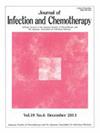Evaluation of antibiotic de-escalation based on the DASON criteria by pharmacist-led post-prescription review and feedback: A retrospective study in a medium-sized Japanese hospital
IF 1.9
4区 医学
Q3 INFECTIOUS DISEASES
引用次数: 0
Abstract
Introduction
Among antimicrobial stewardship team (AST) activities, de-escalation, which is aimed at optimizing antibiotic use, lacks a standardized evaluation method. The Duke Antimicrobial Stewardship Outreach Network (DASON) criteria provide a framework for assessing de-escalation; however, their applicability in small to medium-sized hospitals in Japan has remained unclear. We aimed to evaluate the effectiveness of AST pharmacist-led post-prescription review and feedback (PPRF) using multiple indicators, including de-escalation based on the DASON criteria, to determine whether these indicators are also applicable in medium-sized hospitals.
Methods
A retrospective study was conducted at a 330-bed hospital, comparing pre-PPRF (April 2021 to March 2022) and post-PPRF (April 2022 to March 2023) periods. The effectiveness of AST pharmacist-led PPRF was evaluated using the de-escalation rate determined by the DASON criteria, inappropriate antibiotic use in definitive therapy, days of therapy (DOT), and days of antibiotic spectrum coverage (DASC) per DOT.
Results
The de-escalation rate significantly increased from 20 % to 45 % (P < 0.01), and inappropriate antibiotic use in definitive therapy decreased from 7 % to 0 % after AST pharmacist-led PPRF. While DOT significantly increased from 11 days to 13 days (P = 0.02), no significant change was observed in the DASC/DOT ratio.
Conclusion
This study suggests that de-escalation based on the DASON criteria can be an effective quantitative indicator for evaluating AST pharmacist-led PPRF in medium-sized hospitals. The findings also suggest that incorporating multiple indicators tailored to each hospital's conditions can provide a more comprehensive framework for evaluating AST pharmacist-led PPRF.
药师主导的处方后评价和反馈基于DASON标准的抗生素降级评价:日本一家中型医院的回顾性研究
在抗菌药物管理团队(AST)活动中,旨在优化抗生素使用的降级活动缺乏标准化的评估方法。杜克大学抗菌药物管理推广网络(DASON)标准提供了评估降级的框架;然而,它们在日本中小型医院的适用性仍不清楚。我们的目的是评估AST药剂师主导的处方后审查和反馈(PPRF)的有效性,使用多个指标,包括基于DASON标准的降级,以确定这些指标是否也适用于中型医院。方法在一家拥有330个床位的医院进行回顾性研究,比较pprf前(2021年4月至2022年3月)和pprf后(2022年4月至2023年3月)的时期。AST药剂师主导的PPRF的有效性通过DASON标准确定的降级率、确定治疗中不适当的抗生素使用、治疗天数(DOT)和每个DOT的抗生素谱覆盖天数(DASC)来评估。结果降压率由20%显著提高到45% (P <;在AST药剂师主导的PPRF后,最终治疗中不适当使用抗生素的比例从7%下降到0%。从第11天到第13天,DOT显著增加(P = 0.02), DASC/DOT比值无显著变化。结论基于DASON标准的降级可作为评估中等医院AST药师主导的PPRF的有效定量指标。研究结果还表明,结合适合每个医院条件的多种指标可以为评估AST药剂师主导的PPRF提供更全面的框架。
本文章由计算机程序翻译,如有差异,请以英文原文为准。
求助全文
约1分钟内获得全文
求助全文
来源期刊

Journal of Infection and Chemotherapy
INFECTIOUS DISEASES-PHARMACOLOGY & PHARMACY
CiteScore
4.10
自引率
4.50%
发文量
303
审稿时长
47 days
期刊介绍:
The Journal of Infection and Chemotherapy (JIC) — official journal of the Japanese Society of Chemotherapy and The Japanese Association for Infectious Diseases — welcomes original papers, laboratory or clinical, as well as case reports, notes, committee reports, surveillance and guidelines from all parts of the world on all aspects of chemotherapy, covering the pathogenesis, diagnosis, treatment, and control of infection, including treatment with anticancer drugs. Experimental studies on animal models and pharmacokinetics, and reports on epidemiology and clinical trials are particularly welcome.
 求助内容:
求助内容: 应助结果提醒方式:
应助结果提醒方式:


